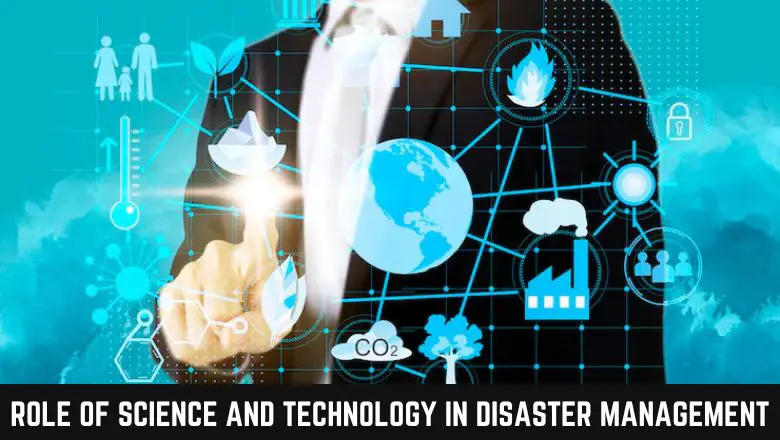In this article, you will get to know all details about the “Role of Science and Technology in Disaster Management“.
The management of disasters is highly effective, and science and technology are of great help. Technology has been greatly modified over the last few decades to expand its capabilities. Saving lives is made possible by it in a variety of scenarios.
During a disaster, lives and wealth are lost due to unforeseen and fatal incidents. Occasionally, nature’s delicate balance is disrupted and different regions are severely impacted.
Tsunamis and earthquakes are examples of this. There are times when man-made mighty war machines cause destruction. Many people around the world lose their lives as a result of these disasters.
Due to the fact that it cannot be stopped nor avoided. Quick response is the only way to minimize its hazardous shock. The technology is being developed to respond quickly and efficiently to catastrophic wars and natural disasters.
Most Common Role of Science and Technology in Disaster Management 2024
Science and technology play an important role in disaster management, as I will explain in this article.
NASA Finder detects humans beneath rubble:
As far as disaster management is concerned, science and technology play an extremely important and promising role. An important tool in disaster management is NASA Finder, which resembles a suitcase. It is used to save people in earthquakes and avalanches.
A severe earthquake or avalanche strikes an area in an emergency. In order to save lives, timely response and quick operation are essential. Heartbeats are detected by NASA’s finder
Within wrecked buildings or debris, humans are able to breathe.
It is impossible for a human to detect the precise location where a victim is stuck in concrete. Solid concrete up to 20 feet deep, it can detect a human or another living being.
With Finder, you can quickly locate the victim and provide aid to them. Finder has shown very promising results in a number of severe earthquakes and disasters.
Robots and drones for rescue operations:
Drones and robots are emerging technologies with a wide range of applications. In almost every situation, drones and robots can be modified to perform tasks.
When a disaster strikes, the government and other agencies reach the affected area quickly and gather information. To plan a rescue operation and a strategy, they need to visit as soon as possible.
Using drones and robots to manage disasters is a marvelous use of technology.
As a result of the wreckage, drones are very helpful in reaching those areas that a human cannot reach quickly. By capturing live video and using cameras installed, it collects the information.
It allows the rescue team to view the damage from a different angle and conduct the operation more effectively. The plane drops aid and food for the victims.
In the same way, robots can be remotely sent into collapsed buildings to locate victims. A robot usually consists of a wheeled vehicle with a camera.
When it comes to rescuing and emergency operations, time is of utmost importance. It is impossible for humans to go inside small cracks and holes. For quick rescue operations, robots quickly locate the victims in the wreckage.
Earthquake warning system:
An earthquake is one of the most horrendous natural disasters that affect millions of people around the world.
Science and technology play an important role in disaster management to counter the damaging effects. It is possible to determine the magnitude of an earthquake with the help of an earthquake warning system.
A seismometer measures the motions of the earth and an accelerometer measures the acceleration of that motion to determine the magnitude of an earthquake. Computers display this data in an analytical format.
Authorities are alerted to the severity of the disaster by the data displayed on computers. Based on the warning system, the rescue operation is initiated more comprehensively.
Forest fire preparedness:
The threat of forest fires to both humans and animals is great. In addition to damaging the property, it can result in huge economic losses as well.
The disaster moves at a slow pace and expands rapidly. The danger it poses is very difficult to curb after it has expanded.
It is possible for forest fires to cause massive destruction if they are not contained on time, such as the Australia fire of 2019. Almost a billion animals were killed as a result of the destruction of about 18 million hectares of land.
Fires can cause serious damage, so we must keep this in mind. A timely response has been made possible by the incorporation of technology.
From helicopters or satellites, remote sensing and thermal images and heat signatures can be acquired. Day and night, mid-infrared and light emitted by the fire assist with response and rescue operations, as well as protecting economically important farms.
Also, the images are used to assess and map vegetation and burned land in order to cover the losses.
FINAL THOUGHT:
As explained above, technology plays a very important role in disaster management. It is particularly GPS technology and communication technology that are essential to disaster management and timely response.
The GPS system locates the area of disaster very quickly, and the communication technology facilitates real-time information flow. It is also important to appreciate the use of modern technologies such as drones and robots in disaster management.
As a result of robots and drones, disaster victims have more chances of surviving. There is no pause in the world’s disasters and calamities. They have happened in the past and they will happen in the future. For loss minimization and loss prevention, we rely on technology.
In my upcoming articles, I will write more about technology’s influence. I would be happy to answer any questions you may have about the “Role of Science and Technology in Disaster Management“. Please feel free to contact me with any questions you may have.
Keep up reading and learning with Rehmat Ullah.

